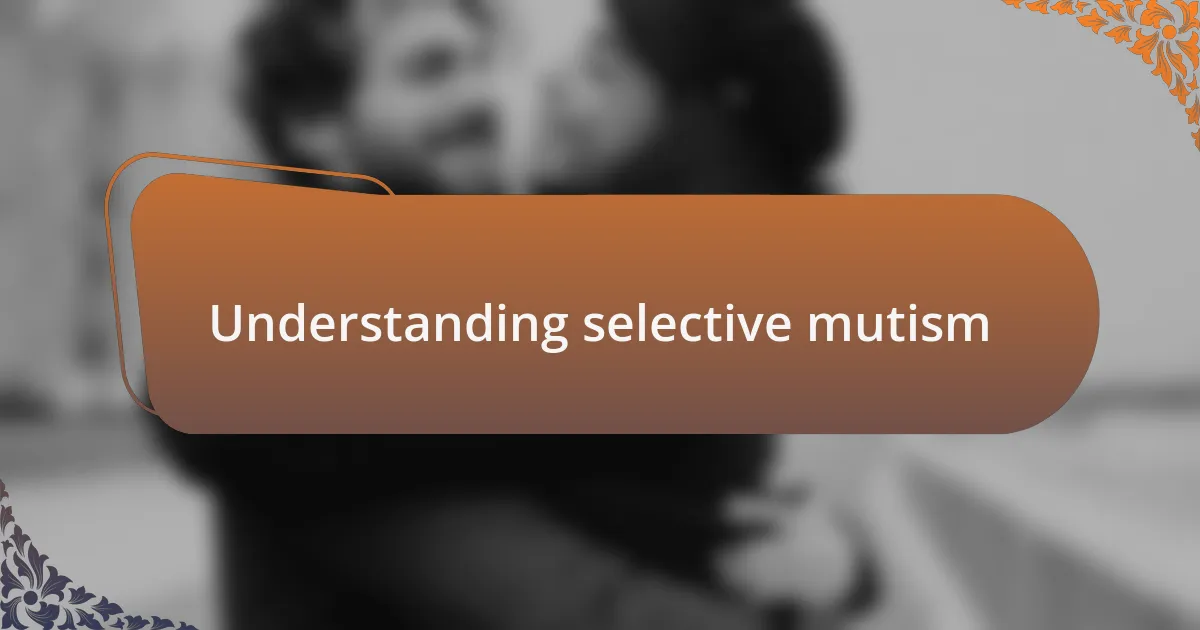Key takeaways:
- Selective mutism is a complex anxiety disorder that affects children’s ability to speak in specific social situations, often leading to feelings of isolation.
- Therapeutic methods, such as cognitive-behavioral therapy, play therapy, and parental involvement, are crucial in helping children overcome their communication barriers.
- Personalized therapy that incorporates a child’s interests and encourages flexibility can significantly enhance engagement and progress in communication.
- Building trust and consistency in therapeutic approaches helps create a safe space for children, fostering their willingness to express themselves over time.

Understanding selective mutism
Selective mutism is often misunderstood, yet it’s a complex anxiety disorder where individuals, typically children, struggle to speak in certain social situations despite being able to communicate comfortably in others. I remember a time when my niece, who would chat away at home, suddenly fell silent in her kindergarten class, leaving her teachers baffled. How perplexing it was for them, as well as for her, to navigate a world where words felt trapped inside.
Living with selective mutism can feel isolating. I’ve seen first-hand how friendships can falter when a child wants to connect but is held back by anxiety. The struggle to voice thoughts or feelings in a group can create an emotional chasm that’s hard to bridge. I often wonder, what would it take for a child to feel that sense of security to speak freely among peers?
Understanding selective mutism goes beyond just the inability to speak; it’s about recognizing the deep-rooted fear that accompanies it. As I took the time to learn more about this condition, I gained insights into how vital a nurturing environment is for those affected. Have you ever noticed how a warm smile or encouraging words can transform someone’s ability to open up? These small gestures can make a world of difference in empowering those who find themselves caught in silence.

Importance of therapeutic methods
Therapeutic methods are crucial when addressing selective mutism, as they provide structured support to help individuals find their voice. I recall a moment when my friend’s child began therapy. Initially, he was anxious and reluctant, but over time, I saw the shift as he learned to express himself in a safe space. It was inspiring to witness how specialized techniques, like gradual exposure and play therapy, fostered his confidence in social situations.
The right therapeutic approach can be transformative, acting as a bridge towards overcoming the daunting silence that often accompanies selective mutism. As I watched my niece’s progress in her therapy sessions, I was struck by the power these methods held. They not only equipped her with tools to cope but also instilled hope for a future where she could freely share her thoughts. Have you ever experienced a breakthrough moment that changed everything? Those moments are so impactful, and I believe they are the heart of truly effective therapy.
Establishing a connection with a knowledgeable therapist can make all the difference. I remember when my own therapist introduced me to mindfulness techniques that helped me manage my anxiety. It made me realize how vital it is for therapists to understand their clients’ unique needs. It’s not just about speaking; it’s about creating an environment where individuals feel understood and empowered to take that first step towards communication.

Common therapeutic approaches
Common therapeutic approaches for selective mutism encompass a range of methods designed to help individuals gradually express themselves. One popular technique is cognitive-behavioral therapy (CBT), which focuses on changing negative thought patterns associated with speaking. I remember attending a workshop where a therapist shared success stories of children who overcame their fears through guided exposure exercises. Watching them conquer their anxiety was nothing short of uplifting.
Play therapy is another effective approach, offering a non-threatening environment where kids can communicate without the pressure of spoken words. I vividly recall a session where a child used dolls to express feelings he couldn’t put into words. It was eye-opening to see how play can unlock emotions and foster connection. Have you ever considered how play can be such a powerful medium for expression? It truly highlights the importance of creativity in therapy.
Another method is the use of parent-child interaction therapy, which not only involves the child but also their parents, fostering communication within the family unit. I found it fascinating to learn how parents could be guided to encourage dialogue in a supportive manner. Reflecting on this, I could see how strengthening family relationships can lead to significant improvements in a child’s willingness to speak. It’s a reminder that healing often starts at home.

Choosing the right method
Choosing the right therapeutic method for addressing selective mutism can feel overwhelming, but it’s essential to consider what resonates most with the individual. I once collaborated with a therapist who emphasized the importance of tailoring the approach to meet the unique needs of each child. During our sessions, I observed how a child thrived with a blend of play therapy and cognitive-behavioral techniques, which helped create a balanced atmosphere for both expression and relaxation.
In my experience, it’s crucial to trust your instincts about what feels right. I recall a time when I had to decide between two different methods for a young participant. I chose to prioritize play therapy, which proved to be a game changer. Watching the child gradually engage in conversations through games left me in awe of how a familiar and comfortable environment can shift a child’s willingness to communicate. Have you ever noticed how comfort can change someone’s entire outlook?
Ultimately, the journey to finding the right method is often trial and error, and that’s perfectly okay. I remember the initial apprehension I felt when trying new techniques, but each small victory brought a sense of accomplishment. It reminds me that patience and perseverance are key; sometimes, the path to finding the right fit is just as significant as the method itself.

Personalizing therapy for effectiveness
Personalized therapy can truly transform the experience of addressing selective mutism. I recall a young girl I worked with who responded positively to a customized approach that incorporated her love for animals. By utilizing animal-assisted therapy, we created a safe space for her, enabling her to express herself more freely. It made me wonder how powerful it can be to connect with a child’s interests on such a personal level.
I’ve found that flexibility in therapy styles is key. For instance, during one of my sessions while experimenting with storytelling techniques, I noticed a quiet boy light up when I introduced interactive elements. Suddenly, he wasn’t just a passive listener; he became a crucial part of the experience. Isn’t it fascinating how a simple shift can foster engagement and lead to breakthroughs?
Moreover, I believe the ongoing feedback from the child can guide the therapeutic process. After incorporating a few new strategies, one child shared her feelings about our sessions, and this open dialogue reshaped our next steps significantly. It reaffirmed my belief that therapy is not a one-size-fits-all solution. How often do we consider a child’s voice in shaping their own journey? By prioritizing their input, we can develop a truly personalized therapeutic approach that resonates.

My journey with new methods
As I ventured into new therapeutic methods, I vividly remember the first time I introduced visual aids like emotion cards. One little girl, initially withdrawn, lit up as she recognized her own feelings in those images. Watching her connect these emotions to her experiences felt remarkable; it was a turning point for us. Could these simple tools truly unlock deeper communication?
Adapting therapeutic techniques often led me to unexpected moments of clarity. There was a time I suggested role-playing games, and during one session, a boy took on the persona of a superhero. His transformation was exhilarating. Suddenly, he found his voice, even if just for those fleeting moments. It made me reflect: how often can play, that simple act, become a bridge to self-expression?
Integrating mindfulness practices was another path I explored, and it surprised me how effective this was. One child struggled with overwhelming anxiety, but after we practiced calming techniques together, he shared how it made him feel “lighter in his chest.” Those moments reinforced my belief that adapting to new methods isn’t just about technique—it’s about nurturing a safe emotional environment. Isn’t it amazing how small shifts can nurture profound changes?

Lessons learned from my experience
Lessons learned from my experience
Each time I tried a new method, I discovered that flexibility was key. I remember a moment when a child resisted traditional talking therapies. Instead, I introduced a storytelling approach. The change in her demeanor was palpable; she began to share her thoughts through her own narratives. That taught me the importance of meeting children where they are, rather than forcing them into a mold.
One technique that resonated deeply with me was incorporating art therapy. I recall a session where a young boy poured his feelings onto a canvas. As the colors flowed and blended, so did his emotions. It was eye-opening to witness how creativity could serve as a voice for those who felt unheard. This experience reinforced my understanding that expression comes in many forms and that sometimes, silence speaks louder than words.
Over time, I learned that consistency in approach fosters trust. I remember building a routine with one particularly anxious child who craved stability. As we revisited familiar strategies week after week, he slowly began to engage in conversation. It dawned on me that reliable methods can act as anchors for the children. Isn’t it fascinating how trust can transform a relationship and open up possibilities for communication?